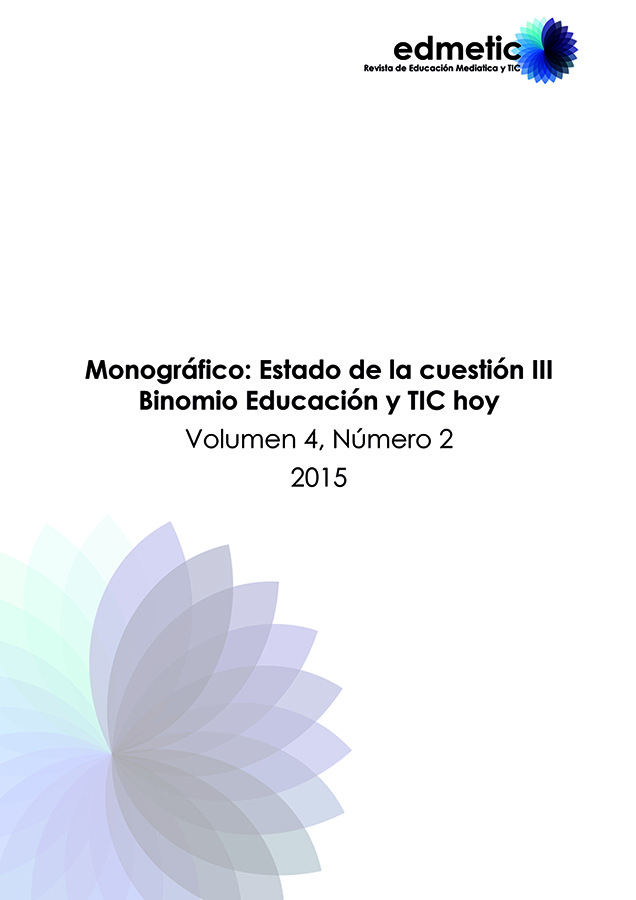Redes sociales aplicadas a la educación: EDMODO
Main Article Content
Abstract
El artículo que a continuación abordamos, versa sobre un proyecto de innovación educativa que trata de incorporar las Redes Sociales a la educación analizando su valor didáctico. Esto se realiza a través del aprendizaje y posterior uso de una plataforma educativa llamada EDMODO.
Abordaremos el tema del aprendizaje mixto o blended learning, facilitando su concepto y las ventajas que esta metodología aporta al proceso de enseñanza-aprendizaje. Finalizaremos este primer apartado analizando de manera global el concepto de comunidades virtuales y las ventajas que éstas proporcionan a la práctica docente. De forma más detallada, nos centraremos en una de estas comunidades virtuales, llamada EDMODO, en la cual se centra nuestro proyecto de innovación. Una vez examinado el marco teórico de este proyecto, pasaremos a tratar los objetivos, la metodología y la aplicación del mismo. Llegados a este punto, tendremos la información necesaria para analizar los resultados positivos obtenidos y extraer las conclusiones oportunas sobre la necesidad de aplicación de las redes sociales en contextos educativos, concretamente EDMODO. Para terminar este proyecto, analizaremos las futuras líneas de implantación de estas redes sociales en los centros educativos y su futura viabilidad.
Downloads
Article Details
TRANSFER RIGHTS AND COMMITMENTS TO EDMETIC, REVISTA DE EDUCACIÓN MEDIÁTICA Y TIC
E-ISSN: 2254-0059
The undersigned author(s) of article entitled:
- Transfer to EDMETIC, Revista de Educación Mediática y TIC publishing rights of the article mention before. The magazine will have the right to publish in any format or media this article.
- The author(s) claim that this article is original and which has not been published before in any format and wasn´t submitted for evaluation to another publication.
- The author(s) claim that this article has the copyright´s permissions for publication
- The author(s) accept the changes to the contents on the review, and changes in the style of the manuscript by the Editorial Board of EDMETIC, Revista Educación Mediática y TIC.
- The author(s) declare that they have complied with the ethical principles of research.
- The author(s) not be subject to personal or business association that involves a conflict of interest with article presented
- El author(s) undertakes to give the primary sources of information, if requested.
Date:
Author(s) names and signatures (1):
(1) Fill the form and send to: revistaedmetic@uco.es
References
ALONSO, S., Y ALONSO, M.M. (2014). Las redes sociales en las universidades españolas. Revista de Comunicación Vivat Academia, 126, 54 – 62.
ALONSO, S., Y PALOMARES, A. (2013). Percepciones de la función tutorial en el Espacio Europeo de Educación Superior del alumnado de la Facultad de Educación de Albacete (UCLM - España). Journal for Educators, Teachers and Trainers, 4(2), 160–168.
ARNAL AGUSTÍN, J., DEL RINCÓN IGEA, D., LATORRE BELTRÁN, A., Y SANS MARTIN, A. (1995). Técnicas de Investigación en Ciencias Sociales. Barcelona: Dykison.
BARTOLOMÉ A., Y AIELLO M. (2006).Nuevas tecnologías y necesidades formativas Blended Learning y nuevos perfiles en comunicación audiovisual. España: TELOS.
BARTOLOMÉ, A. (2002). Universidades en la Red. ¿Universidad presencial o virtual? Crítica, LII 896, 34-38.
COATEN, N. (2003). Blended e-learning. EducaWeb, 69. Monográfico sobre Formación Virtual.
DANS, E. (2009). Educación on-line. Plataformas educativas y el dilema de la apertura. Revista de Universidad y Sociedad del Conocimiento, 6(1), Recuperado el 05 de Febrero de 2010.
DE LA TORRE, A. (2006). Definición de Web 2.0. Bitácora de Aníbal de la Torre. 12 de abril 2006.
DEANS, C. (2009). Social software and Web 2.0 technology trends. USA: IGI-Global.
GARRISON, D.R., Y Kanuka, H. (2004). Blended learning: Uncovering its transformative potential in higher education. The Internet and Higher Education 7(2), 95-105.
GRAHAM, C.R. (2005). Blended Learning Systems: Definition, Current Trends, and Future Directions, en Handbook of Blended Learning: Global Perspectives, local designs, Pfeiffer Publishing, 3-21.
LARSON, R., Y MURRAY, M. (2008). Open educational resources for blended learning in high schools: Overcoming impediments in developing countries. Journal of Asynchronous Learning Networks 12(1), Sloan Consortium, 1-19.
MORÁN, L. (2012). Blended Learning. Desafío y oportunidad para la educación actual. EDUTEC. Revista Electrónica de Tecnología Educativa, 39.
RIBES, X. (2007). La Web 2.0. El valor de los metadatos y de la inteligencia colectiva. TELOS, Cuadernos de Comunicación e Innovación:
SABIN, M., Y LEONE, J. (2009). IT Education 2.0. In: Proceedings of the 10th ACM conference on SIG-information technology education, 2009. Virginia, USA
SINGLE P. B., Y MULLER C. B. (1999). Electronic Mentoring: Issues to Advance Research and Practice. Paper presented at the International Mentoring Association Conference, Atlanta, GA.
